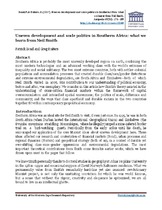| dc.contributor.author | Bond, Patrick | |
| dc.contributor.author | Ruiters, Greg | |
| dc.date.accessioned | 2018-09-20T13:43:05Z | |
| dc.date.available | 2018-09-20T13:43:05Z | |
| dc.date.issued | 2016 | |
| dc.identifier.citation | Bond, P. & Ruiters, G. (2017). Uneven development and scale politics in Southern Africa: what we learnt from Neil Smith. Antipode 49(S1): 171–189 | en_US |
| dc.identifier.uri | http://dx.doi.org/10.1111/anti.12248 | |
| dc.identifier.uri | http://hdl.handle.net/10566/4066 | |
| dc.description.abstract | Southern Africa is probably the most unevenly developed region on earth, combining the most modern technologies and an advanced working class with the world’s extremes of inequality and social militancy. The two most extreme countries, both with settler–colonial populations and accumulation processes that created durable class/race/gender distortions and extreme environmental degradation, are South Africa and Zimbabwe—both of which Neil Smith visited in 1995. His contribution to our understanding of political economy, before and after, was exemplary. We consider in this article how Smith’s theory assisted in the understanding of crisis-ridden financial markets within the framework of capital overaccumulation and intensified spatial unevenness; the politics of scale, difference and community; and the ways that class apartheid and durable racism in the two countries together fit within contemporary geopolitical economy. | en_US |
| dc.language.iso | en | en_US |
| dc.publisher | Wiley | en_US |
| dc.rights | This is the author-version of the article published online at: http://dx.doi.org/10.1111/anti.12248 | |
| dc.subject | Capitalist crisis | en_US |
| dc.subject | Resistance | en_US |
| dc.subject | Solidarity | en_US |
| dc.subject | Scale | en_US |
| dc.subject | Uneven development | en_US |
| dc.subject | Urbanisation | en_US |
| dc.title | Uneven development and scale politics in Southern Africa: what we learn from Neil Smith | en_US |
| dc.type | Article | en_US |
| dc.privacy.showsubmitter | FALSE | |
| dc.status.ispeerreviewed | TRUE | |
| dc.description.accreditation | ISI | |

